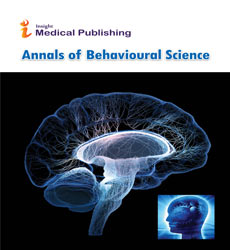Anxiety and Panic Are Prevalent Throughout the General Population
Shengtao Chen *
Department of Psychological Medicine, Institute of Psychiatry, Psychology and Neuroscience, King's College London, UK
- *Corresponding Author:
- Shengtao Chen
Department of Psychological Medicine, Institute of Psychiatry, Psychology and Neuroscience, King's College London, UK
E-mail: shenc@gmail.com
Received date: October 26, 2022, Manuscript No. IPABS-22-14910; Editor assigned date: October 28, 2022, PreQC No. IPABS-22-14910(PQ); Reviewed date: November 08, 2022, QC No IPABS-22-14910; Revised date: November 21, 2022, Manuscript No. IPABS-22-14910 (R); Published date: November 28, 2022, DOI: 10.36648/2471-7975.8.7.78
Citation: Chen S (2022) Anxiety and Panic are Prevalent throughout the General Population. Ann of Behave Sci Vol. 8 No.7:78
Description
The most prevalent mental illness is anxiety. Changes in psychomotor way of behaving can be seen in gross coordinated abilities, with step aggravations remembered to reflect damaged mind capabilities in mental circumstances. Anxiety-related balance problems are well-documented, but little is known about how people with anxiety walk. This study aims to determine whether people with anxiety and healthy people have different gait, balance, mobility, and muscle strength, as well as the relationship between anxiety level and motor characteristics. This is, to our knowledge, the first study of its kind to look at anxiety patients' spatiotemporal gait components. The findings suggest that anxiety patients could benefit from having gait analysis, as well as muscle strength, balance, and mobility function, included in their physical examinations. Patients who suffer from anxiety may benefit from a more positive outcome if these aspects are properly evaluated and treated. The severity of a child's anxiety is negatively correlated with effective control-the capacity to suppress impulsive responses in favor of more adaptive responses. Increased effortful control may "slow down" automatic, threat-laden interpretations, thereby lowering children's anxiety, as one possible explanation.
Anxiety and Panic
This hypothesis was put to the test by looking at how interpretation biases influenced associations between effortful control (and its subcomponents) and anxiety symptom severity in a diverse group of young people who were clinically anxious. The symptoms of anxiety and panic are prevalent throughout the general population. People who go to Emergency Rooms (ERs) typically have physical symptoms of anxiety and panic. Therefore, it is essential for emergency department physicians to be aware of the numerous causes of anxiety and panic and equipped to respond appropriately. The pathophysiology of the physical symptoms of anxiety and panic, as well as possible diagnoses, are discussed in this paper. An emphasis is placed on organic conditions that are connected to anxiety and panic symptoms. ED clinicians can use brief interventions to explain symptoms and encourage individual self-management. Uneasiness in malignant growth patients can influence recuperation time, medicine adherence, and patient personal satisfaction. Dhikr therapy has been shown in some studies to improve relaxation and reduce anxiety, but little is known about its use with cancer patients. The purpose of this study is to ascertain whether or not dhikr therapy helps cancer patients feel less anxious. A quasi-experimental, non-equivalent control group design was used in this study's quantitative approach. Twenty people from the intervention group and twenty from the control group participated in the study, which took place between April and May of 2018.In the intervention group, dhikr therapy is administered once daily for a minimum of ten minutes.
Correlate Improvement in Anxiety
The Visual Analog Scale for Anxiety was used to measure anxiety. The Mann–Whitney test and the Effect Size (ES) were used to measure the effect of dhikr therapy. Two types of anxiety-state anxiety and trait anxiety-are measured by clinically based anxiety questionnaires. State anxiety is fleeting and change-sensitive; A tendency to be anxious that is widespread is trait anxiety. In order to measure the change in participant state anxiety following the visit and to correlate improvement in anxiety with visit satisfaction, our study aims to identify the causes of women's anxiety about the initial consultation for their pelvic floor disorders. A smartphone-based system was used to evaluate the anxiety symptoms of 84 BD patients daily for nine months. During follow-up, data on each patient's clinically evaluated anxiety symptoms, functioning, and patient-reported stress and quality of life were gathered at five predetermined time points. The validity of using smartphones to self-report anxiety symptoms in BD patients who were in complete or partial remission was demonstrated. Even when anxiety is completely or partially gone, it is linked to more stress, a lower quality of life, and less ability to function. As a result of the clinical impact of identifying anxiety symptoms, smartphones may be a useful tool. Attentional focusing appears to be more relevant for both depression and anxiety symptoms in a clinical sample than attentional shifting, in contrast to studies conducted on non-clinical samples. The development of neurocognitive interventions that help people focus better is bolstered by these findings. These results should be replicated, particularly in longitudinal studies. Beyond age-related cognitive deficits, late-life depression is associated with diminished cognitive function. This study sought to investigate the relationship between anxiety symptoms and cognitive function among older inpatients treated for depression, as comorbid anxiety frequently occurs in late-life depression. Across all cognitive domains, we hypothesized that comorbid anxiety symptoms would have an overall additive effect on dysfunction. The prognosis of depression in the elderly study's 142 patients with late-life depression were included in the study.
Open Access Journals
- Aquaculture & Veterinary Science
- Chemistry & Chemical Sciences
- Clinical Sciences
- Engineering
- General Science
- Genetics & Molecular Biology
- Health Care & Nursing
- Immunology & Microbiology
- Materials Science
- Mathematics & Physics
- Medical Sciences
- Neurology & Psychiatry
- Oncology & Cancer Science
- Pharmaceutical Sciences
